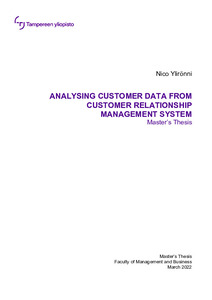Utilization of customer online data in customer acquisition : case Surf
Saarinen, Kimmo (2015)
Saarinen, Kimmo
2015
Yrityksen taloustiede, markkinointi - Marketing
Johtamiskorkeakoulu - School of Management
This publication is copyrighted. You may download, display and print it for Your own personal use. Commercial use is prohibited.
Hyväksymispäivämäärä
2015-06-04
Julkaisun pysyvä osoite on
https://urn.fi/URN:NBN:fi:uta-201506111683
https://urn.fi/URN:NBN:fi:uta-201506111683
Tiivistelmä
Customers’ buying process is continuously shifting to online channels also in business-to-business markets. To address this dramatic change, companies need to provide valuable online content for customers to support them in the buying process. As customers search solutions for their needs and challenges on website, their behavior is being tracked. This behavioral data, customer online data is increasingly important for companies to utilize in sales and marketing. Most of the Finnish SMEs have still challenges in utilizing customer online data because the lack of knowledge and slow adoption of new technologies.
The purpose of the study is to explore and analyze how customer online data can be utilized in customer acquisition through marketing performance measurement and creation of customer intelligence. Since an academic literature is rather scarce on this topic, the study is emphasized on the empirical part of the research. The case study was selected as a research strategy. The case here is Finnish company named Surf which sells and markets primarily interior and exterior panels and services related to them. The main target group is architects who have significant role when deciding building materials.
A qualitative approach was primarily used to conduct this study. The data was generated through two methods, three semi-structured interviews and non-reactive data collection. These methods supported each other to create holistic, yet in-depth description of the case. Persons, who were interviewed, are responsible of sales and marketing in the case company. Non-reactive data included data of the website visitors generally as well as specific data of the leads. The data was collected from June 1st 2013 to May 31st 2014.
It was discovered that generating and utilizing lead specific data is important both in marketing performance measurement and creation of customer intelligence. What is more, it was shown that closing the loop between sales and marketing is crucial in understanding a whole journey from website visitor to customer. Although in this case, utilization of customer online data was primarily tactical and operative, there are also possibilities to utilize the data strategically.
After analysis, it was identified six main topics how customer online data can be utilized in customer acquisition: 1) Optimization of website and marketing activities, 2) Selection and budget allocation of marketing activities, 3) Improvement of lead qualification, 4) Segmentation and targeting, 5) Focus of content creation and 6) Initial sales approach.
The purpose of the study is to explore and analyze how customer online data can be utilized in customer acquisition through marketing performance measurement and creation of customer intelligence. Since an academic literature is rather scarce on this topic, the study is emphasized on the empirical part of the research. The case study was selected as a research strategy. The case here is Finnish company named Surf which sells and markets primarily interior and exterior panels and services related to them. The main target group is architects who have significant role when deciding building materials.
A qualitative approach was primarily used to conduct this study. The data was generated through two methods, three semi-structured interviews and non-reactive data collection. These methods supported each other to create holistic, yet in-depth description of the case. Persons, who were interviewed, are responsible of sales and marketing in the case company. Non-reactive data included data of the website visitors generally as well as specific data of the leads. The data was collected from June 1st 2013 to May 31st 2014.
It was discovered that generating and utilizing lead specific data is important both in marketing performance measurement and creation of customer intelligence. What is more, it was shown that closing the loop between sales and marketing is crucial in understanding a whole journey from website visitor to customer. Although in this case, utilization of customer online data was primarily tactical and operative, there are also possibilities to utilize the data strategically.
After analysis, it was identified six main topics how customer online data can be utilized in customer acquisition: 1) Optimization of website and marketing activities, 2) Selection and budget allocation of marketing activities, 3) Improvement of lead qualification, 4) Segmentation and targeting, 5) Focus of content creation and 6) Initial sales approach.
Kokoelmat
Samankaltainen aineisto
Näytetään aineisto, joilla on samankaltaisia nimekkeitä, tekijöitä tai asiasanoja.
-
Customer Value Co-Creation through Reverse Use of Customer Data
Saarijärvi, Hannu
Acta Electronica Universitatis Tamperensis : 1129 (Tampere University Press, 2011)
VäitöskirjaAsiakastiedon hyödyntämisessä on kehittymässä merkittävä muutos. Sen sijaan että yritykset hyödyntävät asiakastietoa omissa sisäisissä prosesseissaan, asiakastiedosta jalostetaan asiakkaalle merkityksellistä informaatiota ... -
Analysing Customer Data from Customer Relationship Management System
Ylirönni, Nico (2022)
DiplomityöOrganisations collect vast amounts of data from their business environment and process it in order to support their decision-making and gain benefits. Before the value is created for the organisation, the data needs to be ... -
Differentiation of a Customer Engagement Model for Mid-market and Enterprise Customers in Software-as-a-Service Company
Rashid, Sahil Azher (2019)
DiplomityöIt is critical for a Software-as-a-Service (SaaS) company to meet its customers’ expectations of level and quality of service and engagement or alternatively set their expectations right in order to meet them, as failure ...



